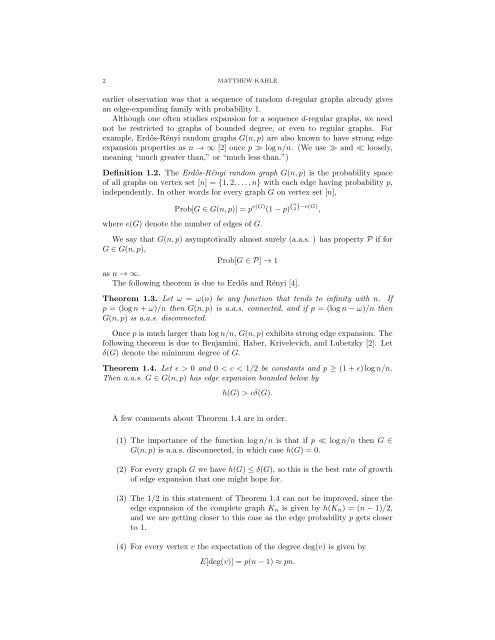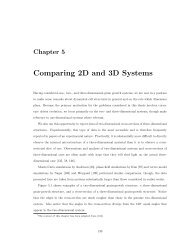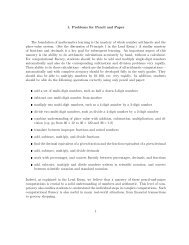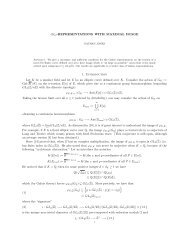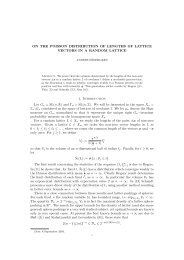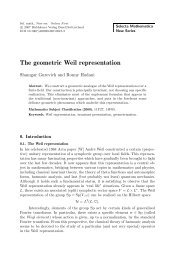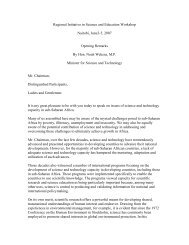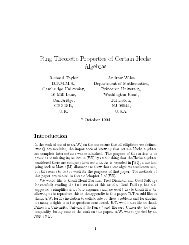TOPOLOGICAL EXPANDERS 1. Introduction Expander graphs ... - IAS
TOPOLOGICAL EXPANDERS 1. Introduction Expander graphs ... - IAS
TOPOLOGICAL EXPANDERS 1. Introduction Expander graphs ... - IAS
Create successful ePaper yourself
Turn your PDF publications into a flip-book with our unique Google optimized e-Paper software.
2 MATTHEW KAHLE<br />
earlier observation was that a sequence of random d-regular <strong>graphs</strong> already gives<br />
an edge-expanding family with probability <strong>1.</strong><br />
Although one often studies expansion for a sequence d-regular <strong>graphs</strong>, we need<br />
not be restricted to <strong>graphs</strong> of bounded degree, or even to regular <strong>graphs</strong>. For<br />
example, Erdős-Rényi random <strong>graphs</strong> G(n,p) are also known to have strong edge<br />
expansion properties as n → ∞ [2] once p ≫ logn/n. (We use ≫ and ≪ loosely,<br />
meaning “much greater than,” or “much less than.”)<br />
Definition <strong>1.</strong>2. The Erdős-Rényi random graph G(n,p) is the probability space<br />
of all <strong>graphs</strong> on vertex set [n] = {1,2,...,n} with each edge having probability p,<br />
independently. In other words for every graph G on vertex set [n],<br />
Prob[G ∈ G(n,p)] = p e(G) (1−p) (n 2)−e(G) ,<br />
where e(G) denote the number of edges of G.<br />
We say that G(n,p) asymptotically almost surely (a.a.s. ) has property P if for<br />
G ∈ G(n,p),<br />
Prob[G ∈ P] → 1<br />
as n → ∞.<br />
The following theorem is due to Erdős and Rényi [4].<br />
Theorem <strong>1.</strong>3. Let ω = ω(n) be any function that tends to infinity with n. If<br />
p = (logn + ω)/n then G(n,p) is a.a.s. connected, and if p = (logn − ω)/n then<br />
G(n,p) is a.a.s. disconnected.<br />
Once p is much larger than logn/n, G(n,p) exhibits strong edge expansion. The<br />
following theorem is due to Benjamini, Haber, Krivelevich, and Lubetzky [2]. Let<br />
δ(G) denote the minimum degree of G.<br />
Theorem <strong>1.</strong>4. Let ǫ > 0 and 0 < c < 1/2 be constants and p ≥ (1 + ǫ)logn/n.<br />
Then a.a.s. G ∈ G(n,p) has edge expansion bounded below by<br />
h(G) > cδ(G).<br />
A few comments about Theorem <strong>1.</strong>4 are in order.<br />
(1) The importance of the function logn/n is that if p ≪ logn/n then G ∈<br />
G(n,p) is a.a.s. disconnected, in which case h(G) = 0.<br />
(2) For every graph G we have h(G) ≤ δ(G), so this is the best rate of growth<br />
of edge expansion that one might hope for.<br />
(3) The 1/2 in this statement of Theorem <strong>1.</strong>4 can not be improved, since the<br />
edge expansion of the complete graph K n is given by h(K n ) = (n −1)/2,<br />
and we are getting closer to this case as the edge probability p gets closer<br />
to <strong>1.</strong><br />
(4) For every vertex v the expectation of the degree deg(v) is given by<br />
E[deg(v)] = p(n−1) ≈ pn.


